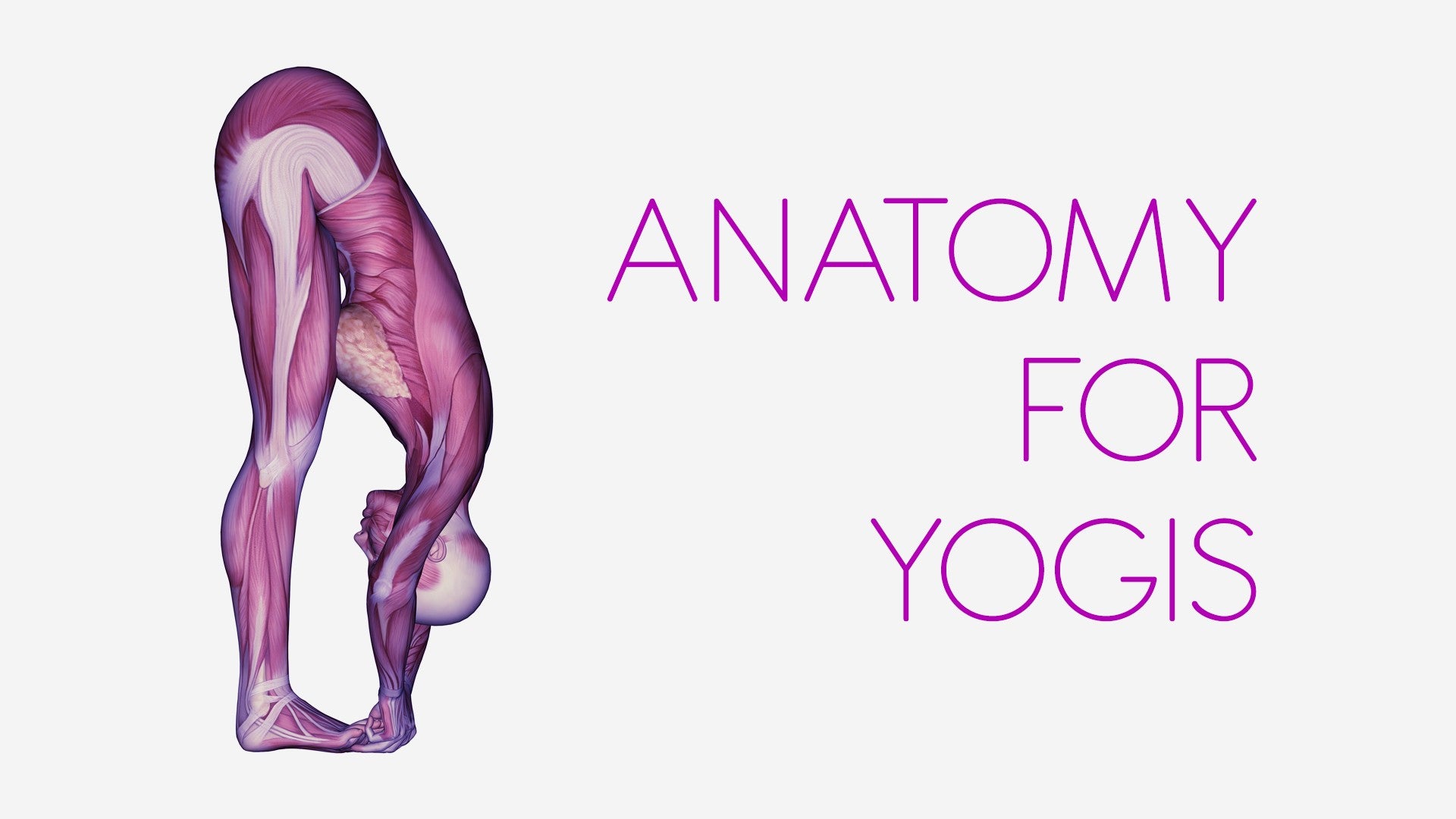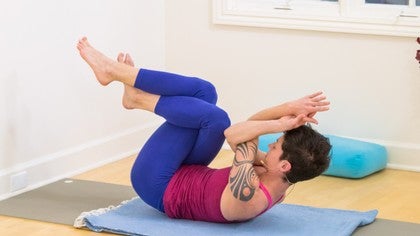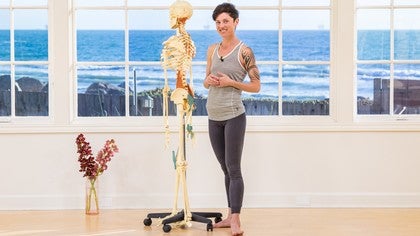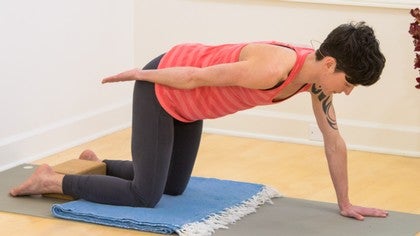Description
About This Video
Transcript
Read Full Transcript
Hey, everyone. Welcome back. We're about to do a strengthening series for the abdominal wall. You have a lot of muscles in your abdomen. They wrap all the way around your torso. And they're pretty long, so they go from your lower ribs all the way down to the top of your pelvis bones. And the way that we want to think about the abdominal wall is something that is really supportive in three dimensions. Obviously, your spine is at the middle of your torso. And we want to have a really strong, healthy spine. And this is important, obviously, for posture and for a general sense of well-being, but also for your organ health. When you think about abdominal strength, I'm going to encourage you not to think about something that's really tight or sometimes we hear the word corset. And for me, at least, that gives the impression of something that's cinched and laced up. This part of the body is meant to be soft. Your organs are there. And my opinion is that for general health, we do want somewhat of a feeling of softness and ease in this part of the body. So as we work, we're going to be working with smaller ranges of movement and more subtle strengthening work. We'll also be doing a lot of work to incorporate the leg strength into the core or the torso strength. If at any point you feel that it's challenging to continue breathing, take a pause and then continue again. So the most important thing really is that you're having a good time, that you feel supported in your body. So we're going to start off lying on our backs. I like to have a blanket just to cushion my back against the floor. We'll go through a couple of different movements. I'm going to use a wall. At the end, I'll do some restorative work with a bolster. Again, for me, it's really important to incorporate a sense of softness and relaxation with all the strengthening work that I do. So you'll want a bolster around as well. All right. So when you're ready, go ahead and lie down on your back. All right. So the first bit of strengthening work we're going to look at is really just a deep flexor strength. And starting with your knees bent, feet flat on the floor, go ahead and start to reach forwards through your fingertips so that you feel just the tops of your shoulders start to lift up. And then from here, you're going to want to draw your belly button back towards the floor a touch and bring your head up off of the floor so that you can look down at your belly button. All right. So for a lot of us, this is where we're going to stay. If you feel right here and you want to extend your legs forwards, go ahead and do so. At any point, if it's too much for your neck, you can bring your hands behind your head and give a really gentle support with your arms. However, what we want to do is start to build the deep flexor strength from your neck and your throat all the way down to your belly. There's a tendency to look up here, and I'm going to encourage you not to do that. So keep looking down towards your belly button. If you want to continue from here, go ahead and lift one leg up. If one leg feels easeful, then go ahead and lift two. I'm going to try and talk while I do this. If two legs up is all right for you and you want to continue for the next one, then you'll reach your hands back behind your head. Inhale into your back. And when you're ready to come down, go ahead and gently on an exhale, come on down. All right. So for the next pose, we'll use the wall. And again, I like to have a blanket for support for my spine. You'll want to position yourself here so that your feet are at the wall and they're kind of in line with your knees. You'll want at least a 90-degree bend through your knees, definitely not less, potentially a little bit more. So before we start, go ahead and just start to use your hands behind you, but press your feet into the wall. And notice when you feel your belly and your back kind of register that push. And there's a way that you can push your feet into the wall and let the push of your feet actually kind of almost come straight into your belly button. And that's the type of engagement you'll want through your legs. So keep your feet pushing forwards into the wall. And then if it's possible, bring your hands forwards. Okay. So again, you can stay right here. If you want to continue from here, start to round your back. It's almost like you're going through a little bit of a C shape. Some of us will come down just about halfway. If at any point you start to shake or if it feels like you can't continue to come down without support, then stay. If you can continue to come all the way down, again, chin towards your throat, rolling all the way down, you can bring your arms back. Okay. So coming up is a little bit of a tricky part. You'll want to take an inhale here.
And then as you exhale, same as the last movement, bring your chin forwards and into your throat and then push into your legs to come all the way up and reach your arms up. All right. So we're going to link it with breath. Inhale here and reach up through your hands. As you exhale, start to curl your spine back, pushing through your feet as you come down. On an inhale, reach your arms back. And then with your exhale, bring your arms up, chin in towards your throat, push through your legs and all the way up on an inhale. Okay. Chances are good you're sliding back from the wall. So continue to adjust yourself as you need. Okay. Inhale and then exhale and roll down. Keep your feet pressing into the wall and inhale your arms back and exhale coming up. It's always an option to use your hands and grab ahold of your thighs for support. Let's do three more. Last one. All right. So if that felt good, you can continue with that variation. Second variation is with a twist. So you'll start the same way, taking an inhale to reach your arms up. Exhale to roll back. Inhale, arms back. And then this time as you exhale, you'll come up and over to one side and up. Inhale. Exhale. And over to one side and up. All right. So let's do three in both directions. Take an inhale. Exhale and down. Inhale. Exhale coming up into this side. Inhale and exhale. Scoot in every time.
Okay. Last two. So one in each direction. All right. And then exhale and release your arms down. So from here, we're going to come onto our backs again. This time we'll take a variation with legs. Probably most of you are familiar with eagle legs. So I'll cross one leg over the other. If it's comfortable and you want to wrap your upper foot below your calf, that's fine. If that's not comfortable, just hug your poor legs in towards one another. And then you'll take eagle arms as well. So whatever leg is on top, that arm can come to the bottom. And you'll twist tie your forearms. And if the hands don't wrap, then go ahead and just bring your hands to your shoulders. All right. So from here, you'll take an inhale when you're down on the floor. And then with your exhale, you'll want to bring your elbows and your knees towards each other. And again, we're working with a smaller range of movement here. So think about your belly button kind of just dropping back towards the ground. And let that movement be the thing that's bringing your limbs towards each other rather than your limbs initiating. So first movement is navel back. Take an inhale. And then exhale. We'll do, let's do five. So inhale on the ground. So after the fifth one, you can release your arms out. And then go ahead and uncross your ankles if they are crossed. And bring your feet to the floor. And then let your legs drop the direction of the upper leg. So as your legs drop, the bottom leg side, you want to think about relaxing from your ribs all the way down to your inner thigh. And taking some deep belly breaths. So letting your belly expand with your breath. And then when you're ready, come back to the center and we can do the other side. Any of these you can increase your reps. You'll probably want to increase no more than up to, I'd say 20 on each side. And just start to include them as part of your daily practice. All right.
So whatever leg is on top, bring that arm underneath. And we'll start by inhaling. And then exhaling. You can let your legs come down, uncross your ankles. And then again, whatever leg is on top, allow your legs to fall that direction. And bring your breath awareness into the space between your ribs and your hip. And inhale deeply. And then you can come back to the center. Okay, so I had to move my blanket back and my body back a little bit from the wall. You might need to as well. The next movement that we're going to do has a similarity to canoe, to the pose that we started with. So you can start with your knees bent and your feet down. On an exhale breath, bring your chin towards your throat. And here you want to lift your shoulder blades all the way off of the floor. From here, take both of your feet up towards the ceiling and bring your arms forwards. On an exhale breath, drop your legs so that your feet are in line with your forehead. Take an inhale. And then with your exhale, roll your pelvis to one side and try and keep your chest facing straight up towards the ceiling. Inhale, come back to the center. And exhale to the other side. Now back to the center. So we'll do five each way. Inhale. So as you're moving, you want to keep your chest straight up. Or as straight as you can. Shoulders off the ground. And that's a twist. You're thinking about taking one half of your pelvis over the other. And when you're done with five, go ahead and bring your knees back to your chest and let your head rest down. So between all of these movements, just give yourself a couple of breaths or whatever you need if you want to do a little bit of a bridge or another type of stretch between them. Right? So the next movement that we'll do requires some awareness through your midsection in order to not go into a back bend. We'll bring our legs up at 90 degrees. And pretty much as soon as you bring your legs up, you might feel that your pelvis wants to tilt almost like you're wagging your tail back. And where you want to be here is not in a big tilt, but it's also not in a strong tuck. So you'd like to find a place that's kind of called the neutral spine or what's in the middle of either extreme range of movement. And what you might do is just experiment with some pelvic tilts on your own and notice when you take your tail back, the back bend shape that you get in your lower back, or when you tuck your tail towards your heels that your back flattens against the floor. And find some place that feels fairly easeful in the middle. Now that ease isn't going to unfortunately probably won't be something that you feel when your legs are lifted up. But you'll think about the three dimensions of your torso wrapping in towards the center of your body. And when you lift your legs up, you'll keep that three dimensional wrapping and then also think about lengthening through the center of your body. So I find that for myself, if I keep my head and upper body engaged in this, it's easier than just firming around my torso. Then bring your arms up and let the weight of your arms rest back towards your shoulders. Option one from here is to just take one leg down at a time and tap your toes to the floor. Now notice that here I'm moving from my hips and the bend in my knees is pretty much staying the same. Option two is both legs at once. So let's do maybe another five and if you're doing one leg at a time, go ahead. And then if you're doing both legs, go ahead. And I'm going to do a couple with both legs. So again, I'm still reaching through my head, feeling all sides of my torso hug around and support me. All right. So then we'll pause with the legs just at 90 degrees. And from here, you'll just use your arms. Now one thing is you want to keep your arm bones resting back, so upper arm bones resting in the shoulder joint. Try not to lift your shoulders too far back away from the floor, but think about the weight of your arms resting back and then from here, bring your arms back and tap the ground. And we'll do five here. So it's up to you if you want to repeat doing one set, either your legs and your arms one at a time, or if you want to give both a try at once. And we'll do five. And when you're finished with five, go ahead and bring your knees in towards your chest and the soles of your feet together. So your knees come out. Take your hands and wrap them around your ankles or your shins. If it's possible, you can bring them around the little toe sides of your feet. And then let the weight of your thighs rest down towards the floor. Let your knees relax out. Take a couple of deep breaths all the way down into the lowest part of your belly. So again, for me, it's important that after doing strengthening work, there's also some more relaxing work that's done. And especially when we're working in the abdominals, this isn't a place in your body where you want to live with a lot of hardness or tension all the time. So ideally you do strengthening so that it's supporting to you in your activities. But then you can also relax this part of your body too, especially if you're eating or laughing, enjoying your life. All right. So from here, bring one ankle to cross over the other. And now take your arms outside of your knees and reach around and grab ahold of the little toe sides of your feet. So you'll hug the soles of your feet towards the backs of your thighs. And for me, this provides just a nice release for my lower back and belly. And again, I'm letting my belly relax as much as I can while I inhale. And then switch which ankle is on top. All right. So from here, we'll, um, roll onto our bellies and do some strengthening for the lower back. And you'll come into sphinx pose. So in sphinx pose, I want my elbows below my shoulders and arms bent at about 90 degrees. Now, if this is causing pain or tension for you in your low back, you can bring your elbows further forwards and that's fine. One thing to think about either way, and especially for those of us that are experiencing tightness in the low back here, is that from your belly button area, from your waist area, if you think about kind of going out a couple of inches to either side, so maybe two or three inches to the right and the left of your belly button, you can kind of imagine that that's where the tops of your legs are.
And you want your legs to be pretty active here so that you initiate a reach from your waist, from your midsection all the way into your toes, even beyond your toes. All right. From here, push down right into the center of your forearms and breathe into your chest. On your next exhale, turn your gaze towards your belly button, push down into your elbows and see if you can lift your belly just a touch up off the floor. And then inhale and come back to the first position. So let's do a couple of movements just like this. We'll inhale and sphinx. And then as you exhale, push down into your elbows and curl your gaze towards your navel. The reach of your legs is continuous the entire time. Let's do one more like this. From here, go ahead and come all the way down onto your belly. And we'll start with the right hand over the left and your forehead just resting down onto your knuckles. So again, your legs are going to stay active the entire time with this next movement. And it's especially important that you give an equal amount of attention to both legs. So here, reach out through your right leg. Feel your right toes long. And then keep the right leg and toes long as you reach out through your left leg and lift your left leg just a touch up off of the floor. And here I want to feel that it's kind of the inside of my thigh and just below my butt that's doing more of the work to lift my leg up. And then I can let my leg drop down. And then again, I'll lift the left leg up. And this time I'm going to take it about maybe halfway of what I can. And then I'll drop it down. And then on the third time, I'll lift my left leg up as high as I can without tipping my pelvis. And again, I'm reaching through both legs all the way to the toes. And then drop it down. I'm going to keep reaching through both legs evenly. And on my next inhale, I'll lift my torso with the right hand glued to my forehead. It's like a salute. And then exhale and come all the way down. I'll do that once more, just like that. So inhale coming up. And then down. And on the third time, I'll come up and take a bit of a twist to the right. Inhale and come up. And then twist to the right. And come down. Okay, so now we'll combine the two movements. I'll inhale, lift the left foot just to touch up off the floor. Right arm and chest. And then come down. My right leg is still reaching long. And inhale, left leg halfway up. And down. And then on the third time, I'll lift my leg up as high as I can get. And then this time, twist. And down. Okay. Switch which hand is on top. Keep the left leg reaching long this time. And inhale, take your right leg up just to touch. Okay. So again, I want kind of more of my upper back thigh, less of my butt that's working. And then right leg, probably about halfway up. And down.
And then right leg up as high as you can get without tipping your pelvis. And down. Okay. Keep reaching long through both legs. We'll inhale the torso and the left arm up. And down. And once more like that. And down. Okay. And then last time coming up and twist to the left. And down. And then combining all of those. Okay. So we'll inhale, right leg just to touch. And down. Right leg halfway. And down. And then right leg high and twist with the left elbow. And down. All right. From here, bring your hands underneath your shoulders. Press yourself up and back. And let's take a child's pose with knees just about as wide as your armpits for a couple of breaths. Okay. Let your elbows rest down onto the ground. Let your head rest. Breathe into your back. Okay. And then go ahead and roll up. So we'll finish today's series with a restorative version of Supta Baddha Konasana or Reclined Bound Angle Pose. And this variation with the blanket is one that I really like for loose hips. So it gives support right into the hip joints. And you'll want to unfold your blanket the long way. And then make a roll with it. Like so. And then grab a hold your bolster. And sometimes in this pose, we bring the bolster up against the back of the sacrum. For today's version, though, you'll want maybe about five or six inches between your back and the bolster. So that we'll have kind of more of a backbend or more of a lift in the upper body and release for the front wall of the abdomen. Bring your blanket roll in front of you. All right. So the blanket is going to help keep your feet together. And then you can take the sides of the roll. And here where I want to position them is just right up at the top of my thigh bone. So you might even be able to feel it on your own body. So my bum is going to stay on the floor. The blanket isn't lifting me up off of the floor. But the blanket is keeping my hip joint kind of aligned here so that I don't ever spread the front of my hip joint. All right. So what I feel when I get up situated in the pose is I feel like I get a nice release or a spread through the front of my belly, through the front of my hips. But that I'm not overstretching, which if you have looser hips like mine, often without the support, there's that potential. And the added benefit of the blanket here is that it lifts my upper thigh bones and helps them seat into the hip joints. Whereas sometimes just with the blocks, there is still the weight of the thigh bones kind of drops more towards the ground. And after some time there, it can feel a little bit like a strain at the inner hips. And then here, let your arms rest out to the sides. You can close your eyes. So the work we've done today has focused on the abdominal wall, the front, the sides, and the back. And now your work is to not work. So with every inhale, you can let your lungs and your diaphragm expand and try and soften completely the muscles around your belly button all the way down to the top of your pelvis. You might even feel like you can breathe into your inner thighs. And then as you exhale, you can do the work of relaxing anywhere else that your body might be holding tension. And so for a lot of us, especially if we experience kind of looser joints, there's actually a constant feeling of alertness or like a holding on in the joints. And this is a chance right now to relax and let go of any effort that you don't need to have so you're in a safe place. And we'll start with the jaw joints. So you can let your lower jaw and your lower teeth kind of rest back. Relax all the way around your ears. Let your eyes rest back away from your eyelids. Relax the base of your skull all the way down to your shoulders from your collarbones out into your arms. Let your hands and your palms relax. Feel your spine supported by the bolster, your pelvis supported by the floor, your hips supported by the blanket. So you can stay here as long as you need to, at least a minute, maybe 10, maybe 20. And in your time here, give yourself this moment. So just allow yourself to completely receive the pose and your breath. And if you're ready to start to transition into the next part of your day, then take an inhale and just start to spread your hands out. Let your eyes open and reach your arms back. And then you can use your hands to bring your legs together. And from here, move your blanket and roll over to your side to use your hands to come up. So at the end of every practice, I like to just take a minute, maybe just one inhale and exhale. Thanks for joining me today. I hope it was fun and interesting to you. Have a great day.
Anatomy for Yogis: Renee Sills
Comments
You need to be a subscriber to post a comment.
Please Log In or Create an Account to start your free trial.












